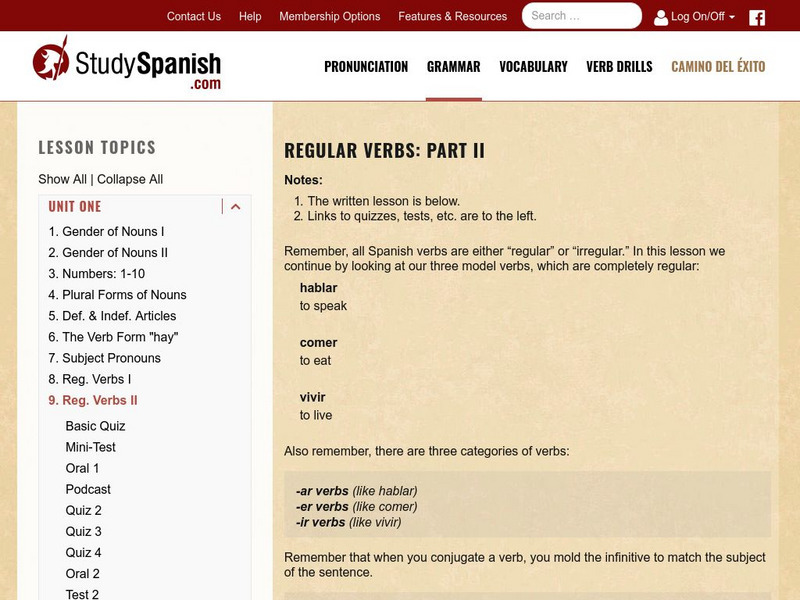Curated OER
Direct and Indirect Object Pronouns
After mastering direct and indirect pronouns, learn the correct sentence structure for having both in the same sentence. This resource provides explanations and clear examples. Consider printing this reference guide on a colored piece of...
Curated OER
Expressions with Tener Explanation
Study tener and show beginning Spanish speakers common expressions that use this verb. But wait! Tener can also serve as a form of the verb "to be?" There's a great chart that helps clarify the verb and its purpose in different situations.
Curated OER
Spanish - Imperative vs. Preterite Tense
Twelfth graders take an online quiz using a website where they differentiate between preterite and imperfect tenses in Spanish. In this Spanish lesson plan, 12th graders use their computer skills and Spanish skills.
Curated OER
¿Ser o Estar?
¿Ser o estar? That is the question! These two are often confused, and if your learners really want to develop their language skills, they need to know the difference! Use this reference sheet to thoroughly explain each ver. The chart...
Curated OER
The Personal a-Explanation and Practice
What is the personal a? It's a tricky concept to Spanish language learners, but this worksheet makes it simple. Examples and an explanation precede a short practice exercise. A great way to introduce your learners to the topic, but...
Curated OER
El Condicional
Are you introducing your intermediate and advanced Spanish speakers to the conditional? Learners conjugate the word in parentheses and insert it into the sentence provided. There are twenty sentences.
Curated OER
Some Adverbs from Feminine Adjectives Grow
Looking for a clear explanation of Spanish adverbs? Here it is! There's a set of seven bullet points that gives the rules, and there is a short practice activity at the end.
Curated OER
Preterite Forms of -AR, -ER, -IR Verbs
Students explore how to form the preterite forms of regular -AR, -ER, and -IR verbs. They complete a variety of written task in which they write the correct preterite forms of the verbs. Students complete a worksheet finding the correct...
Curated OER
El Modo Subjunctivo
Introduce your students to the Spanish subjunctive verb forms with this informative PowerPoint. It includes definitions, examples, and a practice section to assess students.
Curated OER
Object Pronouns with Commands
Intermediate and advanced Spanish language learners will appreciate knowing how to shorten their sentences when making commands. After all, native language speakers usually use informal language when conversing with other native...
Curated OER
Practice with Dar
What does dar mean? How do you conjugate it? Learners use the chart provided to conjugate the target verb. Then, in the second exercise, they use the correct form of the verb to complete each sentence.
Curated OER
Los participios irregulares (El presente perfecto)
Provide your intermediate to advanced Spanish class with practice using irregular participles in the present perfect tense. Simple fill-in-the-blank sentences are provided here, but consider providing a few sentences in English and...
Curated OER
El Presente de Ir
The Spanish verb ir can be used for two separate meanings. Briefly introduce your beginning Spanish speakers to this concept with a few examples. There is no opportunity for practice here, so consider creating a few examples for pupils...
Curated OER
Practice Estar
Because estar is one of the most common Spanish verbs, your class will need a lot of practice with it! First, have them fill in the conjugation chart provided. Then, have them complete a short exercise where they identify the correct...
Curated OER
The Passive Voice with se
Are your Spanish speakers learning about the passive voice? They need this helpful reference tool! These examples will surely help with their sentence construction.
Curated OER
Irregular Familiar Commands
Irregular familiar commands are easy to understand with this chart, and there's a catchy tune provided to help you remember the irregular commands!
Curated OER
Me Gusta
Students draw pictures to illustrate their likes. The pictures are collected and, as a class, students practice talking about the pictures in Spanish.
Curated OER
Creative Dialogues en Espanol
Pupils create a character that could be included in a dialog from stories about Isabel. They use a Venn Diagram to compare and contrast the characters. Students work in groups to create a new character and draw an illustration. They...
Curated OER
Spanish II
Students listen actively to the teacher go over the note sheet and copy down other important information not on the sheet and ask questions about what they do not understand. They then use this information to help them complete...
Trent University
Mas Arriba: Actividades ( Ar Verbs)
This resource allows students to practice using expressions with -ar verbs in the present indicative tense. Read the sentences, view the picture and type in your response. To check your answer, listen to the audio or click on the drop...
Study Languages
Study Spanish: Regular Verbs Part Iii
The third in a series of three lessons,that focus on regular verbs in the present tense. Fantastic summary of regular present tense conjugations and the use of subject pronouns. The explanation is thorough and easy to understand. The...
Trent University
Mas Arriba: Actividades ( Ar Verbs) 2
These interactive exercises practice using -ar verbs. Read the questions, view the picture and type in your response. To check your answer just click on the drop down arrow next to "Respuesta" (answer).
Study Languages
Study Spanish: Regular Verbs Part I
This introduction to conjugating verbs is the first in a series of three lessons,that focus on regular verbs in the present tense. This lesson teaches conjugations that correspond to the pronouns "yo", "nosotros", "usted", and "ustedes"....
Study Languages
Study Spanish: Regular Verbs Part Ii
The second in a series of three lessons,that focus on regular verbs in the present tense. This lesson teaches conjugations that correspond to the pronouns "tu", "el", "ella","ellos", "ellas", and "vosotros". The explanation is thorough...

























